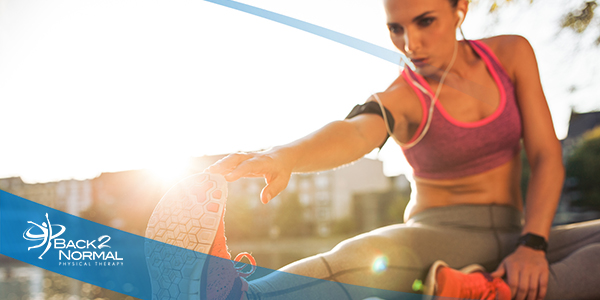
Why Recovery is a Game Changer
Contributing Author: Lisa Chase, PT, CFMM, OMPT, Astym Certified
To achieve success, athletes must have the drive and the commitment to train hard – but more importantly, to train hard and recover harder, and smarter. I’ve been working with athletes of all levels for over 25 years, and I have consistently seen recovery to be the one aspect of training most often overlooked. Lack of recovery practices not only affects your performance but can also leave athletes fatigued and at increased risk for injury. The main “reason” (aka excuse) why athletes don’t commit to proper recovery? Time. Who has time to stop and stretch, when constraints and priorities get in the way? Athletes are often rushing to the next task, taking care of kids, getting to work on time, meetings, deadlines, etc.; the list goes on. The second most common obstacle to proper recovery? Excessive training. (In line with the belief that if some exercise is good, more must be better). And lastly… Athletes are often lacking in regular, appropriate information or techniques to aid them in optimal recovery.
Helping individuals recover from injury and maximizing performance has been my life’s work and passion for over 25 years, and I can tell you – recovery matters, big time. To me, recovery is the low-hanging fruit that can elevate a good athlete to great! So, what is recovery, anyway? And why is it important? Recovery is more than just stretching; it involves understanding the key elements and importance of post-workout routines, proper nutrition, active recovery, and rest. Implementing proper recovery strategies will allow you to train harder, get better results, and will be the difference between average and elite performance – so let’s dig a little deeper.
As athletes exercise, cells break down – creating oxidative stress, inflammation, and depleted energy. As inflammatory markers, such as creatine kinase, become elevated due to exercise-induced muscle damage, muscles become stiff and sore. This is better known as DOMs (delayed onset muscle soreness). Ever notice that soreness from activity peaks within 24-48 hours, and often does not subside for 5-7 days? Think that doesn’t affect your performance? Think again! If you schedule in adequate recovery practices, you can significantly reduce these deleterious effects.
Post-Exercise Recovery
There are 6 key elements of post-workout recovery that include: muscle glycogen replenishment, muscle tissue repair and protein synthesis, hormonal support, soft-tissue repair, immune system support, inflammation reduction, and rehydration. What does that mean for an athlete? Your workout isn’t finished until you’ve replenished nutrients and completed a proper cool down and recovery routine such as:
- Replenish nutrients and maximize cellar repair.
- Aim to consume a 3:1 to 4:1 ratio of carbs-to-protein, in a snack or beverage within 20-30 minutes post-workout or race to replace lost glycogen.
- Drink 4-8 oz of Asea redox signaling supplement to shorten recovery times, reboot your DNA healthy gene expression, lessen soreness, minimize cellular damage, and accelerate the production of your own antioxidants (glutathione) by 500-800%.
- Begin rehydrating right away.
- Drink 20-24 oz of fluid per 1 pound of weight loss to make up for fluid excreted during activity. This is equal to replacing 1.3-1.5 liters of fluid for every 1 kg weight reduction.
- Cool down and stretch.
- Use cardiovascular activity (5-10 minutes) that gradually decreases in intensity, such as a light jog or cycling on a stationary bike. Follow with a static stretching routine (holding 10-30 seconds) for 5-10 minutes, to target specific muscles exercised.
- Incorporate yoga postures at the end of your training sessions and/or restorative yoga with meditation at bedtime to help rejuvenate your mind and body.
- Use hydrotherapies.
- Alternate warm & cool showers 3-4 times to help stimulate muscle recovery, or a quick dip in a cold plunge pool to reduce joint aches and lower body temperature.
- Take an Epsom salt bath with warm water for 20 minutes to help relax muscles, and reduce soreness and stiffness the following day.
- Incorporate cryotherapy by using an ice bag, ice massage, or ice bath to injured or sore areas after cooling down. Or check out our favorite local cryotherapy provider, Elite Body Cryotherapy.
- Support and soothe your muscles.
- Use a myofascial tool, such as a foam roller, pressure relief ball, or massage stick; or invest in a neuromuscular device to help expedite the release of tight or sore muscles, and increase the range of motion and blood flow.
- Try the MELT Method, a self-treatment technique using soft foam roller and treatment balls, to help decrease pain, reduce inflammation, relieve accumulated stress, and improve function and sports performance.
- Apply dōTERRA Deep Blue Muscle Rub (containing therapeutic essential oils) or Renu Gel to boost muscle recovery and reduce soreness and inflammation.
- Use compression socks or Voxx HPT Technology 2-3 hours post-sport or training session.
Active Recovery & Rest
Taking a recovery day doesn’t mean doing absolutely nothing. The purpose of a recovery day is to recoup from training, both physically and mentally. Traditionally, active recovery means performing an easier workout compared to your normal routine. However, it can also mean actively receiving or participating in treatments that enhance your recovery.
Active recovery methods include:
- Working out at a very low intensity, to get the blood flowing and reduce residual fatigue in the muscle;
- Cross-training with activities such as rock climbing, swimming, restorative yoga, walking in nature, paddle boarding, etc.;
- Receiving a professional massage or taking a recovery and/or mobility class;
- Using Bemer technology to deliver a patented pulsed therapy that increases circulation in the body’s smallest blood vessels, enhancing the delivery of nutrients and oxygen to cells while removing toxins;
- Cryotherapy and/or Normatec Compression session;
- Dry needling and cupping.
Rest & Regenerate
Inadequate rest and poor sleep patterns can wreak havoc on your performance, reducing the body’s ability to regenerate, repair and recover.
To enhance quality zzzs:
- Prepare your bedroom for sleep by making it dark & quiet.
- Prioritize getting 7-9 hours of restful sleep.
- Improve HRV and nervous system health with the Inner Balance trainer by HeartMath.
- Use the Oura Ring to monitor your sleeping patterns and cycles.
- Try meditation, prayer, or restorative postures before bed.
- Take a warm Epsom salt bath with a few drops of dōTERRA Lavender essential oil before bed.
- Use the appropriate supportive pillow and mattress for your body.
- Cut off food and drink a couple of hours before bedtime.
- Limit electronics at least an hour prior to sleep.
- Have a nightly journaling and/or gratitude practice.
Don’t let a lack of recovery negatively affect your performance. Develop a plan, determine what works best for you, and implement it methodically. Need help? Seek advisement with our athletic performance and recovery specialists, and let us guide you with the most effective practices. We offer a wellness-focused & supportive environment that can help you achieve your goals. Be sure to check our social media and blog updates for regular wellness inspiration, information, offers and support.
The Back 2 Normal blog is an educational resource written by Back 2 Normal employees and professional associates. Back 2 Normal bloggers are professionals who abide by the code of ethics outlined by their respective professional associations. The content published in blog posts represents the opinion of the individual author based on their expertise and experience. The content provided in this blog is for informational purposes only, does not constitute medical advice and should not be relied on for making personal health decisions.






